PETS IN JAPAN
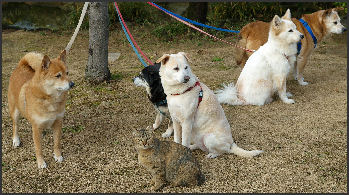
There are 19.3 million pets in Japan, compared to 193 million pets in the United States. The number of pets has increased 50 percent between 1990 and 2000, with the biggest increase among affluent households. The domestic pet market is worth around $10 billion a year and thus far has been recession resistant. [Source: Euromonitor]
A 2004 survey by a pet food company found that among two-person or more Japanese households 23.4 percent owned dogs, 12.9 percent owned cats, 3.7 percent kept goldfish and 5.5 percent kept tropical fish. A total of 52 percent had no pets. Among singles, 8.2 percent owned dogs, 7.9 percent owned cats, 2.6 percent kept goldfish and 2.2 percent kept tropical fish. A total of 79 percent had no pets. Asked why they didn’t have pets, 70.3 percent of the two-or-more person households cited bans on pets in their apartment buildings or housing complexes.
Turtles are popular pets. They are suited for small Japanese houses. They don’t smell much or make noise and can be kept in fish tanks. Hamsters are popular among children and their popularity increased greatly after the Hamuster cartoon became popular. A surprising number of Japanese have ferrets for pets.
Good Websites and Sources: Japan Animals Blog /japan-animals.blogspot.com ; Good Photos at Japan-Photo Archive japan-photo.de ; Kid Web Japan on Pets web-japan.org/kidsweb ; CBS Morning News cbsnews.com ; Photo Blog Report on Japan’s Pet Craze traveljapanblog.com ; 1990s Pet Survey kanzaki.com/jpoll ; Japanese Bobtail Cat cfainc.org//breeds ; Koi Website rockymountainkoi.com ; Good Koi Photos at Japan-Photo Archive japan-photo.de ;
Links in this Website: PETS IN JAPAN Factsanddetails.com/Japan ; EXOTIC PETS, BIRD FIGHTS AND BEETLES IN JAPAN Factsanddetails.com/Japan ; DOGS IN JAPAN Factsanddetails.com/Japan ; DOG BREEDS IN JAPAN Factsanddetails.com/Japan ; BEETLES, LAND CRABS AND INSECTS IN JAPAN Factsanddetails.com/Japan ; ANIMALS IN JAPAN Factsanddetails.com/Japan
Pets and Health in Japan
In the old days dogs were raised on dinner scraps and leftover rice mixed with miso soup and their life span was relatively short. These days dogs are living longer, eating a diet more rich in meat and protein, but are consuming too many calories. One study found that 25 percent of pet dogs in Japan are overweight. Overfeeding and lack of exercise are blamed.
Dogs today live an average of 11.9 years in Japan, In the 1960s when dog food was first introduced they lived three years less. Cats now lives an average of 9.9 years, nearly five years longer than they did in the 1960s.
Pet foods are now divided into general food, natural food without additives and food prescribed by veterinarians. Many pet owners cook up food for their pets or give them the same food as family members. Some dog owners buy meat and organic vegetables for their dogs and are careful to pick food that doesn’t have any additives, spending $200 a month to feed their pet.
Some elderly dogs are overweight and suffer from heart disease and high blood pressure and take medicine to addresses these conditions. Sometimes the animals get little exercise because the owners are also overweight and suffer from heart disease and high blood pressure.
The pet food industry more than doubled in size between 1989 and 2006 to ¥240 billion and now includes low calorie products, products for animals with special dietary needs, as well as dishes for pets that are sick. One man started a company with additive-free pet food after his own dog died and was shocked to see the amount of chemicals that dog food contains.
Pets and People in Japan
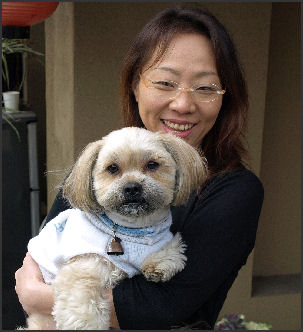
Pets generally have not been allowed in apartments and condominiums. Housing contracts often have a clause that bans animals. These days, though, pets have become so popular that landlords and condominium committees often feel they have no choice but to allow them. Apartments that allow animals are often snatched up and have waiting lists.
Some apartments have special footpaths for animals so their feet are clean when they enter a home. Some condominium committees require pet owners not only to pick up the feces of their animals but any animal feces they see.
Japanese pamper their pets. Many pet owners cook meals for their pets that look more tasty than the food they fix for themselves. One cat owner told the Los Angeles Times that he spends $4,000 a year on his three cats and spends 1,000 hours a year entertaining them. He even provides his pets with there own rooms and computers. "As long as they're happy I'm happy," he said.
Pets clearly provide an emotional need in a nation with a declining birth rate and aging population. One researcher told the Los Angeles Times, "People are starting to see pets as members of their family.” Owners can share graves with their pets. The graves are in cemeteries with no religious affiliation.
A Japanese psychiatrist told the Yomiuri Shimbun that weaker relations among family members and people having fewer children has lead some pet owners to perceive their pets as becoming more important than family members and people in general.
“Therapy dogs” provide comfort to elderly people and patients. One such dog, Chirori, was immortalized in the 2004 movie “Walking With the Dogs: Chirori and Tamaru” in which she played herself. Abandoned and rescued just before she was scheduled to be put to sleep, Chirori was a stumpy-legged mut discovered by Japanese singer Toru Oki. She was given a six month training course in which she learned “eye contact,” “hand signals,” “facial expressions” and how to walk at a speed that corresponds with the speed of the elderly people she accompanies. She was then placed in nursing homes and hospitals. Chirori was so well loved that she was commemorated with a statue after she did.
Pet Shop and Pet Shop Rules
There are 24,000 pet shops in Japan. To open a pet shop, the operator must register at prefectural governments and other places. If a shop repeatedly violates the law, authorities can order them to suspend operations or impose other penalties. [Source: Yomiuri Shimbun]
According to Japan’s Animal Protection Law pet shops are not allowed to display dogs and cats after 8 p.m. The rules, which were approved in January 2012 and went into affect in June 2012, are meant to prohibit display and sales practices that cause stress for young animals. Reporting from Tokyo before the rules were approved, Shinji Aso wrote in the Yomiuri Shimbun, “Some pet shops in the busy commercial districts of large cities remain open even after midnight to attract women who drop by on their way home after working at eating and drinking establishments. However, the puppies and kittens kept in glass showcases at such shops are likely to have health problems since they cannot sleep well due to the shops' lighti ng and the neon outside. Their sleep can also be interrupted by drunken people who come in. [Source: Shinji Aso, Yomiuri Shimbun, December 10, 2011]
At 1 a.m. recently, the inside of a pet shop on a busy Tokyo shopping street was lit with fluorescent lights, and red and purple neon light came in from outside. Of about 30 puppies and kittens in glass cases near a display window, only five were asleep. One puppy barked with excitement whenever a customer entered the shop through an automatic door."Dogs and cats can sleep even in bright light. I don't understand why we can't sell pets at night," a male shop clerk said.However, five puppies were restlessly moving around on a fenced floor where customers could touch them.
“At the Wan Nyan Park 24, a pet shop-cum-pet hotel in Tokyo's Kabukicho district, a curtain on a display window was pulled down at midnight to help dogs sleep. The lights inside cases containing six puppies, including a chihuahua and a poodle, were turned off.Manager Yuichi Kawashima, 33, said there was need to stay open late. "At night, we have female customers who work at eating and drinking establishments and also foreign customers," Kawashima said. A 25-year-old female company employee who visited the shop at 10:30 p.m. said as she watched a puppy, "I can only come at night as my job often finishes late.”
“Experts say puppies and kittens need at least 12 hours of sleep a day for healthy growth. If their sleep is interrupted by bright light or people knocking on display windows, they become prone to illness or agitation. "A pet is an important member of a family," said Katsunori Ota, 69, chairman of the Zenkoku Pet Kyokai (national pet association). "I hope people will buy a pet carefully, with all family members present on holidays, not on impulse at night.”
Pet Services and Businesses in Japan
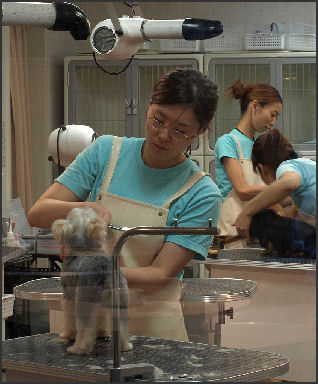
An inn in Yugawara in Kanagawa Prefecture allows dog and ferret owners to take bath with their pets. Cat are generally not allowed because they are afraid of water. The fees are between $10 and $20 for half hour bath. The bath is cleaned after each appointment.
Animals cafes are very popular. The trend began with cat cafes. Now there are more than 120 establishments nationwide that offer exposure to dogs, birds, goats and rabbits. There are so many in fact there are public health concerns as many of the cafes neglect government registrations and sanitary practices.
Realizing there is a lot of money to be made catering to pet owners, major supermarkets have revamped and spruced up their pet sections, hired pet specialists and added more kinds of pet-related goods. A number of hotels have various means of accommodating pets such as having special rooms where owners can stay with their pets or separate rooms for pets whose size varies according to the size of the pet.
Pet owners worried about what might happened to their pets if the owner dies are making wills that assure that the pets are taken care of after the owner dies. According to the Japanese Civil Code, pets are deemed objects and assets can not be left to them so wills are worked out so that money is given to non-family members on the condition they take care of the pets and defines the terms in which the pets are taken care of. Dogs that are put to sleep are given their favorite food, told “God boy, you’ve done your best,” and then given a lethal injection.
Pet owners can purchase pet-locater scanners that consist of microchip in the pet’s collar of the pet or implanted under its skin and a radio scanner that can pick up a signal from the microchip and show the pets location on a map. Benesse Corp. offers health insurance for dogs and cats to address the problem of rising health care costs for aging pets.
Pet Crematories in Japan
There are also pet cemeteries and pet crematories. The businesses that provide these services are unregulated and have a reputation for being a sleazy. There have been a number of reports of these businesses overcharging customers and outright scamming them and crematoria being set up in residential neighborhoods where residents complain about the smell. Particularly notorious are mobile dog crematoria that advertise their service for ¥50,000 and then perform the cremation in an incinerator in the back of a truck and demand ¥300,000 because “optional” items and tell customer if they pay up the bone of their dog will be broken into little bits.
A pet owner whose pet has died can have the cremation done at their homes with a Buddhist priest reading sutras at the funeral ceremony and have the ashes placed in a charnel house resembling a pagoda. Some pets are given funerals like those given people, where the deceased is placed on a futon and family gather around for an all-night wake. Afterwards an altar with the pet’s picture is set up. One person who had such an arrangement told the Yomiuri Shimbun, “because I regarded our pet as one of the family, I had an individual cremation conducted like we would for a human.”
Pet cremation services are divided into ones that cremate multiple bodies at one time and those than cremate a single individuals at a time. The latter category is further divided into two types — ones in which the entire process is left to the service operator and the other in which the pet owners pick up the pet bones from the ashes. The cost for having Buddhist monks read sutras before the pet is cremated is about $400. The cost for an exclusive grave in a pet cemetery and Buddhist rituals conducted on key anniversary dates can run in the tens of thousands of dollars.
It is legal to bury a pet on one’s property but if someone buries a pet in a park or other public place they can be charged with illegal waste disposal. Many municipalities ask pet owners to bring the bodies of their pets to local garbage incinerator to be burned with the garbage. Some places have incinerators reserved only for pets.
In 2010, a funeral operator was arrested for dumping the carcasses of 100 pets on a mountain side. Many of he dumped animals were supposed to have been cremated.
Nursing Care and Health Insurance for Pets in Japan
A survey in 2008 by the Japan Pet Food Association found that 30 percent of Japan’s pet dogs are aged 10 or older. Research by Tokyo University of Agriculture and Technology indicated the average age of dogs rose from 8.6 years in the early 1990s to 11.9 in the early 2000s and the average age of cats rose from 5.1 year to 11.9 years in the same period.
With the average lifespan of pets getting longer and health care cost for pets rising, many pet owners are taking out nursing care and medical insurance for their pets. At nursing care facility for dogs, the dogs are walked and given special snacks that strengthen their jaws. Advanced veterinary facilities like the Bayside Animal clinic in Yokohama offer CT scans, MIRs, ultrasound examinations, and radiation therapy.
Animal Abuse in Japan
There are few laws that protect animals for abuse. Authorities can do little to people who raise animals in inhuman conditions. They can not ban these people from keeping animals or take their animals away with out their consent. There are only four officials in the country that inspect such cases. There was once a case of an elderly man who let 10,000 dogs die over a 10 year period while authorities looked on and did nothing. The man began taking in strays to “save” them but ran out of money and was unable to care for them.
ARK (Animal Refuge Kansai) and WANLIFE are two organizations that rescue abused pets and care and find new homes for them. ARK was founded in 1990 and took in more than 600 animals after the Kobe earthquake in 1995.
Describing a “hell hole of misery” of an irresponsible breeder in Saga, northern Japan, Elizabeth Oliver, the founded of ARK, wrote in the Daily Yomiuri, “noble dogs chained or in cages, unable to escape their prison living months if not years amid feces and hair others perched on pallets surrounded by a stagnant pool of fetid feces and rainwater. Empty dirty food bowls and empty water bowls were encrusted with green algae. The expressions on the dogs’ faces told of their suffering. These dogs had probably not been let of their chains or out of their cages for months. The length of the dogs’ claws indicate they had never been exercised. Skeletons and corpses littered the place.”
Cats in Japan
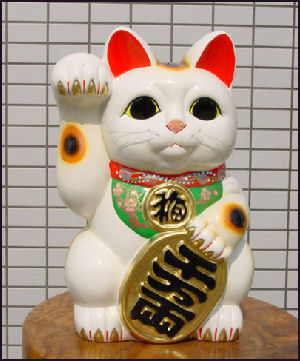
There are 8 million cats in Japan, compared to 63 million cats in the United States. Even though fewer Japanese keep cats as pets than dogs that doesn’t mean they love them any less. Just look at the success of Hello Kitty. On television, you can find prime time shows chronicling the lives of city cats. Websites and blogs about cats are very popular.
There are lot of stray cats running around Japanese cities and lots of cat ladies that look after them. Many of the stray cats have become fat and lazy because so many people feed them. Some people leave out food at their houses and get 30 or more cat visitors, some of whom break into houses to steal food or scratch at windows begging for handouts.
In a 2004 survey by a pet food company Japanese households gave the following reasons for keeping cats (percentage) : 1) cats are adorable (71.1 percent); 2) they like cats (70.3 percent); 3) cats are fun to be around (58.4 percent); 4) cats enrich daily lives (50.4 percent); 5) adopted a stray cat (36.1 percent; 6) cats are indispensable for family communication (35.7 percent). Only 5 percent of people said they kept cats to chase mice.
Some stray cats live in abandoned homes; others sleep in storm drains. At night you can see them creeping across roof tops and hear their banshee howls. Japanese place bottles of water outside their house and against walls and polls and pteh robjects to keep cats from peeing on them. The idea is that if a cat sees its reflection in the water it won’t pee.
Each year 24,000 cats get hit by cars in Tokyo alone. In Osaka, if you find a runover cat you call a number and somebody will come by in less than an hour and clean up the cat and take it away.
Cat Cafes and Cat Station Masters in Japan

tethered cat Neko cafes, or cat cafes, are places where people can relax, sip tea or coffee and spend time with cats. Customers pay around ¥800 for the first hour to play with cats. There are also cat salons where customers pay ¥1,200 to enter a room full of rare breed of cats’such as Himalayans and Persians?and stay as long as they like as well as cafes and restaurants where cat-owners can bring their own pets for snacks and treats and relax and play games.
“Neko no Iru Kyukeijo 299, a cat cafe in Ikebukuro, Tokyo, on a typical night has about 10 customers, some taking pictures of cats with their cell phones and others playing with cats. The 250-square-meter cafe is home to 17 cats and has become a place where single company employees who cannot keep a cat at home can have contact with the creatures. One café in western Tokyo with 19 cats was so busy customers often need reservations to get in, One customer told the Yomiuri Shimbun, “This is just like having my own cat as a pet at home. They have a soothing effect n me.”
One of the most famous cats in Japan is Tama, a calico cat appointed as station master of Kishi Station in Kinokawa, Wakayama Prefecture. The cat has its own office. People make a special visit to the station to have their picture taken with Tama.
A famous shogi player was ordered to stop feeding cat outside his suburban Tokyo home and ordered to pay $23,000 in damages for the noise and excrement generated by the 10 stray cats he fed.
Cat Cafes Rules
Cat cafes will likely be allowed to operate until 10:00pm despite new rules that prohibit the display of dogs and cats after 8 p.m., Environment Ministry officials have said, after revisions were made to the Animal Protection Law. According to Japan’s Animal Protection Law pet shops are not allowed to display dogs and cats after 8:00pm The rules — which went into affect in June 2012 and were meant to prohibit the display of young animals because it caused them stress — also applied to cat cafes but cafe owners complained to the ministry that cats are nocturnal animals and therefore can move around freely and experience less stress at night. [Source: Yomiuri Shimbun, April 19, 2012]
“According to the revisions cat cafe can stay open until 10:00 if they fulfill certain conditions, including: 1) Cats are aged 1 year or older; 2) They can move around freely; 3) They have free access to rest spaces."We greatly appreciate that the panel understood our opinions and will think about whether our industry should impose its own regulations on operations," said Takafumi Fukui, the head of an organization preparing for the establishment of a cat cafe federation of major cat cafe operators.
“In February 2012, Atsuki Kira wrote in the Yomiuri Shimbun, “Cat cafe operators are protesting the government's plan to prohibit all forms of "display" irrespective of the type of business. "Cats are nocturnal animals. [They] are adults and already get enough rest [during the day]," the operator of one cat cafe said. A 39-year-old male salaried worker, who was caressing the back of a striped cat, was appalled to hear that playing with cats after 8 p.m. will be prohibited from June. "I really enjoy coming here after work," he said disappointedly. [Source: Atsuki Kira, Yomiuri Shimbun, February 8, 2011]
“Norimasa Hanada, 40, owner of a cat cafe that stays open until 10, questioned the new regulations in light of the natural habits of cats, which tend to sleep more during the day and become active at night. "Cats are nocturnal by nature. They sleep when they want to and play when they want to," he said. "It's makes absolutely no sense to limit the time.”
“Chieko Henmi, author of "Neko Kafe Meguri" (Cat cafe tour), said if regulations are imposed on the pet industry, it is more important to regulate the minimum hours for pets to rest rather than setting a specific period during which animals can be displayed. "I think shops that treat animals cruelly will be eliminated through natural selection without the need for regulations, as cat lovers would protest shops in which they see tired-looking cats on display," she said.
Goldfish and Carp in Japan
Goldfish raising is taken very seriously in Japan and elsewhere in Asia. The first goldfish in Japan arrived from China at Sakai, near Osaka, in January 1502. Many people have goldfish, tropical fish and hamsters and turtles because dogs aren't allowed in apartments and people regard them as too much responsibility.
Goldfish scooping is a popular summer game. Competitors try to scoop up as many goldfish as possible with a special small nets in a certain time, usually three minutes. The sport is particularly popular in goldfish breeding areas around Osaka. One year the winner was a 52-year-old man who scooped up 160 fish in three minutes. He won a trip to Hawaii. Another year there was big scandal when it was discovered that the winner of a big competition cheated by using a net with an illegal mesh.
History of Goldfish
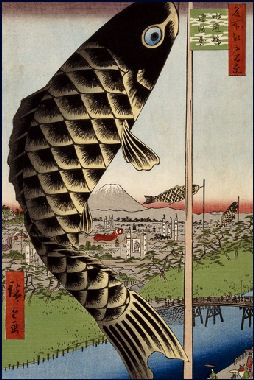
Hiroshige ukiyo-e of a
carp streamer The Chinese are thought to be the first gold fish breeders, producing the first goldfish from carp about A.D 960. The Chinese had traditionally liked to keep fish as pets. They play an important role in feng shui design.
The traditional Chinese interest in dragons — though to originate from the sea — and mythical monsters carries over to fish, whose deformities were segregated and bred. In Sung Dynasty (A.D. 960-1279) goldfish were common household pets. In the 16th century selective breeding was a common practice. In the 18th and 19th centuries King Louis XV of France and the Russian Prince Potemkin took an interest in the hobby. [Source: Paul Zahl, National Geographic, April 1973]
A gold fish can theoretically grow to any size and no goldfish contains pigments other than orange, yellow and black. The other color are a blend of these pigments. Its growth is usually linked by food supply and tank or pond size. And like dogs, no matter how different goldfish look from one another they are all the same species Carassius auratus, a member of the carp of family. [Source: Zahl]
The most bizarre goldfish are called "fancies." These include bubble eyes, which have two fluid-filled marble-size eye sacs; skyward eyes, which have similar eyes except the eyes point forward rather than upward; and the lionhead with puffy nodules that may look beautiful to some but grotesque other. There are also tiger heads, goggle eyes and red-and-white dragon eyes. There are even ones with sea urchin-like eyebrows, who look like a red and white version of the Creature from the Black Lagoon. [Source: Zahl]
Lionhead goldfish are specially breed with massive grotesque orange tumors on their white heads. The growths sometimes cover almost the entire head and gills of the fish. Often the bigger and more grotesque the growth the more valuable the fish. Sometimes a single fish sells for over a US$1000. Moors, usually blue-black in color, tend to turn a reddish color at some point in their lives. An American fish by the name of Old Black Joe reportedly turned red, white and blue during World War I. The value of the fish jumped to US$5000 and was used to promote savings bonds. [Source: Zahl]
Koi
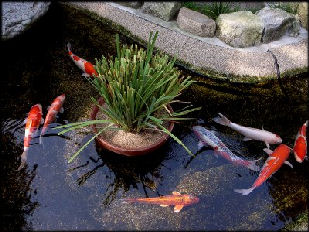
Koi (nishikigoi) is a species of huge carp prized for its long life and delicate beauty. There are stories of 200-year-old fish who let their owners take them out of the water and caress them. Koi are categorized according to about 20 different patterns. Japanese have traditionally valued fish with red and white designs, or tricolored koi with black spots while foreigners prefer colored fish with other patterns.
Carp farming is believed to have originated on the Yayoi period (400 B.C.-A.D. 300). The conclusion is based on the discovery of fossils of young carp teeth at an archeological site near Nagoya in what appears to have been a moat. Tsuneo Nakajima, the curator of the Lake Biwa Museum, which contains the fossils, told Kyodo, “The Yayoi may have released carp into rice fields, moats or ponds during the spawning season and the fish produced eggs. Primitive farming probably started in this way.”
The young carp teeth were found in a different place than adult teeth. It is unlikely the two groups occurred in separation like this naturally and thus suggests fish farming. The technology for fish farming is believed to have been introduced from China along with rice farming,
Carp Breeders in Japan

girls with goldfish necklaces Japan is regarded as the leader in carp breeding. Top quality fish sell for as much as $100,000 at the annual koi fair in held in Tokyo every January. Top breeders are treated like stars and go all over the world giving lectures on their techniques. Hiroshima and Fukuoka prefecture are also famous for carp breeding, Cheap koi are bred in China and Israel.
Yamakoshimura, a village of 2,300 in Niigata prefecture, is regarded as one of world's the main decorated carp breeding towns. The nishikigoi bred here are raised in muddy ponds set among rice fields and transferred to showroom aquariums. People come from all over the world during the buying and selling season in October.
Yamakoshimura also had the distinction of being the place where breeding techniques originated. It said that in the early 19th century villagers began crossbreeding white carp with red carp to produce a new breed, a white koi with red spots on the belly and around the gills. A champion show koi (carp) was sold in 1982 for $165,000. There are stories of Japanese who hand-feed their fish with chopsticks.
Farmers of golden nishikigoi carp in the Niigata area suffered in the earthquake in 2007. More than 1.2 million ornamental carp were killed, nearly half the stock of 2.45 million fish held by 400 crap breeders. Landslides destroyed terraced ponds. Power outages stopped water filtration systems. The damage was estimated at ¥4 billion.
In November 2008, 40 nishikioru carp worth $60,000 were stolen from a pond in Otsu.
High-Priced Koi in Belgium
Belgium is known as major breeding area for koi, There AFP reported: “millions of eggs produce fish sorted by Japanese breeders within weeks, and again, like champion studs, at two-years-old. The very best, judged for their aesthetic qualities, acquire significant value as display items. Among aficionados, koi are considered moving works of art akin to a Picasso, with the world-record price being 350,000 euros ($500,000).” [Source: Roddy Thomson, AFP, September 5, 2011]
Annie Van Alboom of Paradise of Japanese Koi near western Ghent, showed AFP two prize specimen. One is a priceless 37-year-old European Jumbo champion Chagoi 103 centimetres long (more than 40 inches). The other, under heavy security, already sold for 50,000 euros ($72,000) to a Brussels millionaire, she said.
High-Priced Koi and Thievery in Belgium
In September 2011, AFP reported that thieves in Belgium were targeted prized Japanese koi, which are practically un-insurable. "You never get anything back," one breeder told AFP, "You can't insure the fish unless at a massive premium, one third of their value. Materials, equipment, staff, yes -- but not the fish themselves." Lloyds of London confirmed to AFP that there are only a select few policies on the market.
According to AFP: “There is at least a two-decade history of industrial espionage -- theft and poisoning by experienced, organised gangs is an accepted pitfall of the trade. "They've stolen my fish here before, and poisoned my ponds -- criminal gangs working to order," the breeder said. "But now I think it's just someone who wants a luxury product but doesn't have the money." She said the thefts "usually happened in the run-up to a big trade show."
"Ten years ago, thieves stole 17 and then the next year another 38 -- 75,000 euros worth on that occasion," another breeder told AFP. "My father-in-law had a heart attack and died when we discovered the second robbery. They got one year in jail and were out in six months. She also worries how amateur thieves treat the koi. "When I bring mine back from Japan, it's a two-day journey, very stressful," she said. "I leave them in quarantine for 40 days. Sometimes they lie on the bottom of the pond looking dead for up to a week, and don't even eat."The thieves carry only bin bags full of water, "no oxygen". "They pull out the first one with a big net on a long pole -- so the others are terrified. Stress releases poison, and causes real damage to their long-term health," she explained. "This crime is particularly cruel."
Japanese Little Horses
Masanobu Takagi wrote in the Yomiuri Shimbun, "This can't be a horse," I muttered to myself when I saw the ponylike Kisouma at Kisouma Park in Kaida Heights, Nagano Prefecture. When reacting to predators or strangers, horses usually flatten their ears. But the Kisouma is different--it snuggles up to people like a dog rubbing against its owner's legs. Slightly bigger than a pony, the Kisouma are the only native horse found on Honshu and originally come from Nagano and Gifu prefectures. [Source: Masanobu Takagi, Yomiuri Shimbun, December 25, 2011]
"Kisouma have lived with people for a long time, so they're gentle and friendly," explained horse breeder Takeshi Nakagawa, 34, who is raising and training about 30 Kisouma. "Here at the park, we're making major breakthroughs in horse therapy to help soothe psychosomatic disorders.”
“During Genji-Heike battles in the 12th century and conflicts during the Sengoku period (1493-1573), Kisouma carried armored soldiers even though it has a shoulder height of only 130-140 centimeters. The people and horses depicted in period dramas on TV are proportionally very different from the warriors and Kisouma of ancient times, even when the Japanese had a smaller stature than they have today. In the Sino-Japanese War (1894-95) and the Russo-Japanese War (1904-05), Japanese troops were shocked that their warhorses were much smaller than those of their enemies.
“This led to a Japanese military breeding program in which Kisouma and other native horses were crossbred with foreign horses. The program almost sounded the death knell for native horses. The Kisouma survived, however, because the Kiso region--where the horses were bred--is mountainous. Breeders and farmers were able to continue raising the horses in hidden valleys, away from the military's prying eyes. The horse also received important help from the Kisouma preservation association, which was founded in 1969.
“Using a method called kakemodoshi, in which efforts were made to exclusively develop the horses closer to the genuine breed, the association managed to boost the number of purebred Kisouma from about 30 in 1975 to the current 160. Michiyoshi Sakashita, 72, one of the association's founding members, shares his living quarters with a Kisouma. "This horse is a bit too big to be called a pet. But I take care of it because it's so adorable," he said. "I'll probably be the last generation to breed the horse, though.”
“When I rode one of the center's horses, I was a little unsettled because the animal's head is much lower than that of other steeds. When the Kisouma broke into a trot, it seemed to shuffle its feet and I hardly felt as if I was bobbing up and down. This is a unique feature about riding Kisouma.
Image Sources: 1) 2) 3) 5) 6) Ray Kinnane 5) Goods from Japan, 7) British Museum, 8) exorsyst
Text Sources: New York Times, Washington Post, Los Angeles Times, Daily Yomiuri, Times of London, Japan National Tourist Organization (JNTO), National Geographic, The New Yorker, Time, Newsweek, Reuters, AP, Lonely Planet Guides, Compton’s Encyclopedia and various books and other publications.
Last updated October 2012
